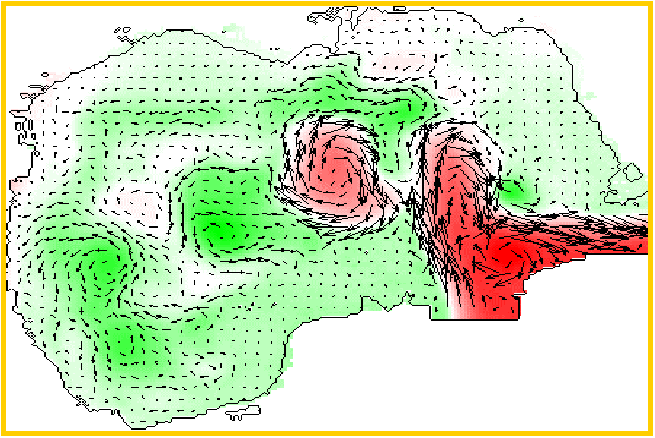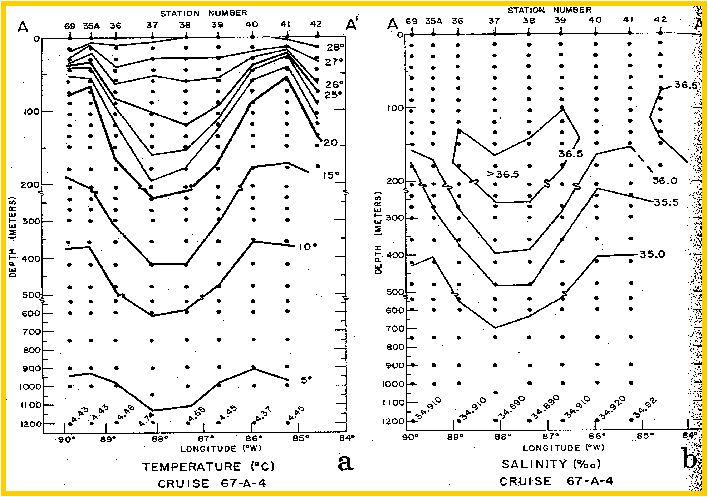
Fig. 1. MICOM model output showing "pinching off or cleaving" of the loop current on the right and
the warm core anticyclonic eddy on the left with associated cyclonic gyres.
OC4331-Mesoscale
Oceanography
Final Project Summary
Topic Area:
LCDR Ashley D. Evans
Two dominant semi-permanent features comprise the circulation in the Gulf of Mexico (GOMEX or GOM): the intense loop current system and the anticyclonic cell of circulation in the eastern gulf. The features are well-known and highly studied. This mesoscale phenomena is critical to the salt heat, momentum and biamass balances of the GOM.
GOM topography and relation to loop current, the loop current and the warm-core rings that are shed every 9-18 months are presented as well as the associated cyclonic gyres. Their formation and separation from the loop current is discussed. The general circulation, variability, and comparisons of these features is shown based on satellite data from GOES 8, TOPEX/ERS and TRMM. Four different models are discussed that run over the GOM. the Bryan-Cox-Semtner model, FOAM (Forecast Ocean Atmospheric Model), CUPOM (Colorado University Princeton Ocean Model) and MICOM (Miami Isopycnal Coordinate Ocean Model).
Colorado Center of Astrodynamics Research Dept of Aerospace Engineering Sciences University of Colorado, Boulder. and Florida State University are leading research institutions that are engaged in day-to-day studies of the GOM features, (among others).
The GOM has one of the most productive fisheries in the United States and serves as the spawning ground for some of the largest fish in the world. The GOM is the spawning ground for the endangered species of Sperm Whale. Texas A&M University is a leading researcher in the field. The oil industry is keenly interested in development of high resolution models to predict spill trajectories as well as current intensity for oil rig platform design. This research is funded through the government contract garnered through the Department of the Interior, Minerals Management Service.

Fig. 1. MICOM model output showing "pinching off or cleaving" of the loop current on the right and
the warm core anticyclonic eddy on the left with associated cyclonic gyres.

Fig. 2: Temperature and Salinity Profiles for the core water for a Warm Core Eddy in the Gulf of Mexico.
Biggs, D.C. and F.E. Muller-Karger, 1994. "Ship and satellite observations of chlorophyll stocks in interacting cyclone-anticyclone eddy pairs in the western Gulf of Mexico." J. Geophys. Res., Vol. 99, 7,371-7,384.
Elliott, B.A., 1982. "Anticyclonic Rings in the Gulf of Mexico." J. Phys. Oceanogr., Vol. 12, 1292-1309.
Lewis, J.K. and A.D. Kirwan, 1985, "Some Observations of Ring Topography and Ring-Ring Interactions in the Gulf of Mexico" J. Geophys. Res., Vol. 90, 9,017-9,028.
Lewis, J.K. and A.D. Kirwan, 1987, "Genesis of a Gulf of Mexico Ring as Determined from Kinematic Analyses " J. Geophys. Res., Vol. 92, 11,727-11,740.
Nof, Doron, 1981. "On the Beta Induced Movement of Isolated Baroclinic Eddies." J. Phys Oceanogr., Vol. 11, 1662-1672
Olson, D.B., 1991. “Rings in the Ocean.” Annu. Rev. Earth Planet. Sci. Vol. 19, 283-311.
Sturges, W., J.C. Evans, S. Welsh, and W. Holland, 1993. "Separation of Warm-Core Rings in the Gulf of Mexico." J. Phys. Oceanogr., Vol. 23, 250-268.
Web Resources:
http://www.ccar.colorado.edu/research/gom/html/
http://www.ssmi.com/tmiregions.html
http://cimss.ssec.wisc.edu/goes/html/
http://www.cfm.brown.edu/people/leonid/GULF/
http://www.-ocean.tamu.edu/Quarterdeck/QD6.1/
http://www.mms.gov/eppd/profiles/gm/
http://forum.swarthmore.edu/man/01/manifoldoc.html
|
This is a government-maintained internet site. Please read the U.S. Navy web page disclaimer and the dislaimer regarding external links. |
|